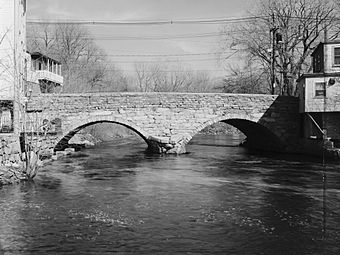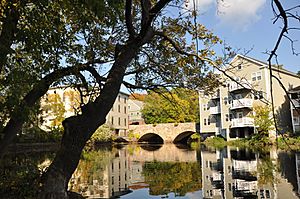Choate Bridge facts for kids
Quick facts for kids |
|
|
Choate Bridge
|
|

Choate Bridge, Spanning Ipswich River at South Main Street, Ipswich
|
|
| Location | Ipswich, Massachusetts |
|---|---|
| Built | 1764 |
| Architect | Col. John Choate |
| NRHP reference No. | 72000137 |
| Added to NRHP | August 21, 1972 |
The Choate Bridge is a very old stone bridge in Ipswich, Massachusetts. It was built way back in 1764. This bridge carries Route 1A and Route 133 over the Ipswich River. It's one of the oldest bridges still standing in North America! It might even be the oldest in Massachusetts.
The Choate Bridge is a special landmark. It was added to the National Register of Historic Places in 1972. It is also known as a National Historic Civil Engineering Landmark. This means it's a really important example of old engineering.
Contents
Building the Choate Bridge
This amazing stone bridge was built in 1764. The town of Ipswich and Essex County helped pay for it. Colonel John Choate was in charge of building the bridge. The bridge was named after him to honor his work. People say he was the first person to ride his horse across it!
Changes Over Time
When it was first built, the bridge was only wide enough for one lane of traffic. In 1838, more stone was added to the eastern side. This made the bridge wide enough for two lanes. The bridge was also fixed up a lot in 1989 to keep it strong.
Other Old Bridges
The Choate Bridge is super old, but there are a couple of other bridges in the United States that are even older and still used. One is the Pennypack Creek Bridge in Philadelphia. It's a stone bridge with two arches built in 1697. Another is a single-arch stone bridge in nearby Rowley, Massachusetts. It was built in 1643, but it was rebuilt in the 1800s.
What Does the Bridge Look Like?
The Choate Bridge is about 72 feet (22 meters) long. It has two big stone arches. Each arch spans about 30 feet, 6 inches (9.3 meters) across. The bridge is made from rough granite stones.
How It Was Built
The original part of the bridge from 1764 is about 20 feet (6 meters) wide. The part added in 1838 made it 16 feet (4.9 meters) wider. The older part of the bridge used lime and mortar to hold the stones together. The newer part used a "dry laid" method, meaning the stones fit tightly without mortar.
The sides of the bridge have low walls called parapets. The wall on the western side is probably from the original 1764 construction. Over the years, the stone parts of the bridge have been repaired many times. This helps keep the historic bridge in good shape for everyone to use.




